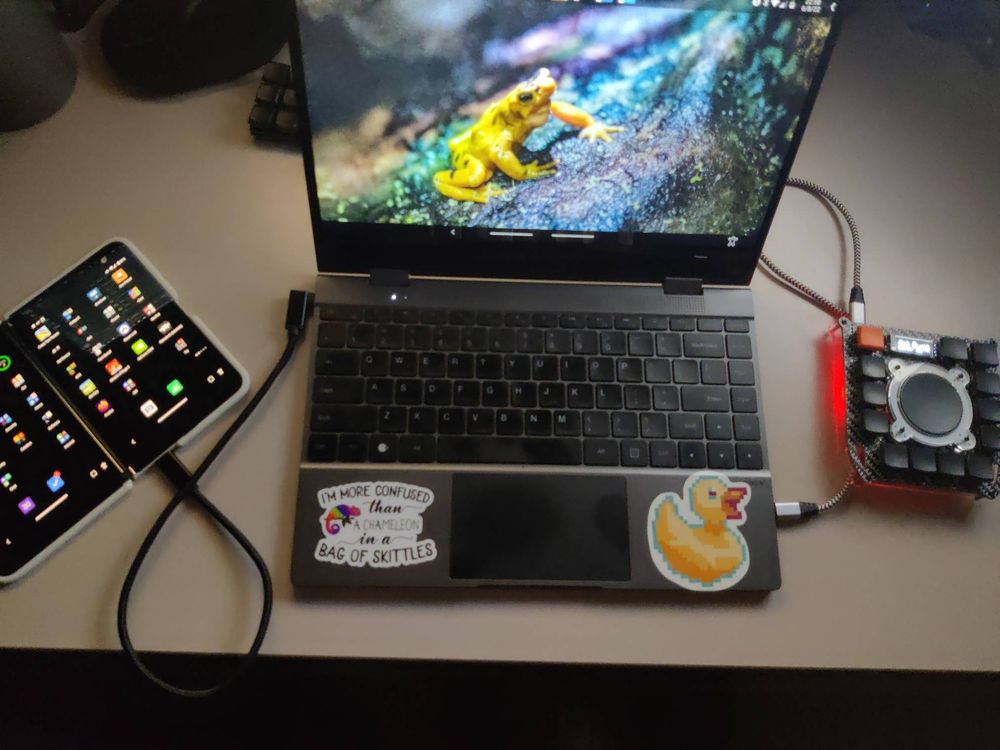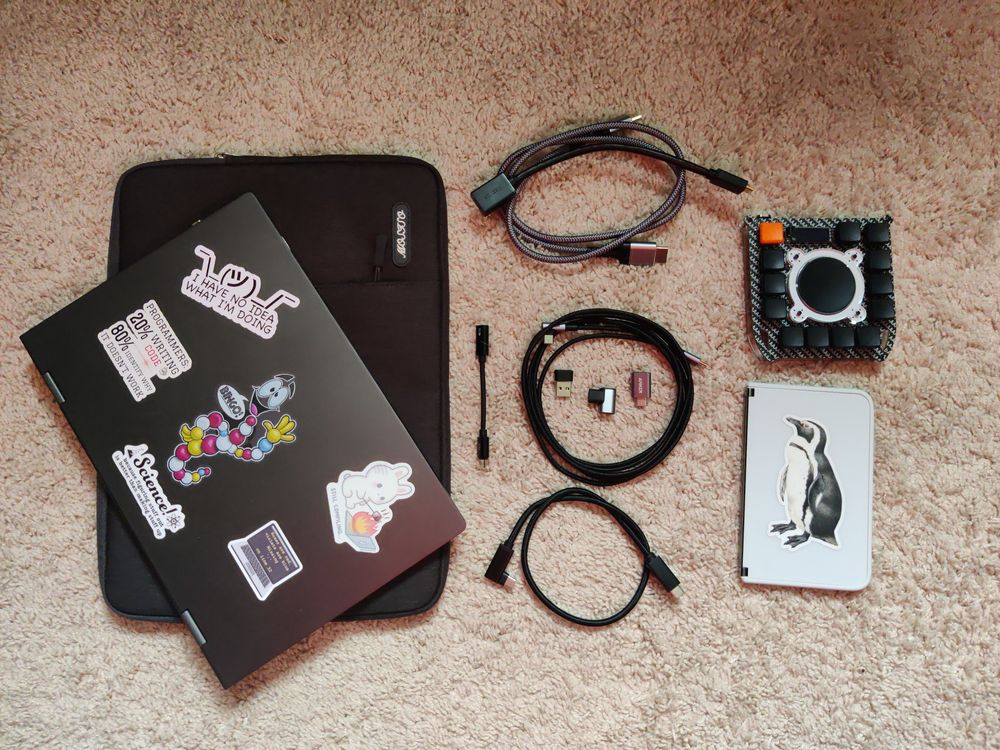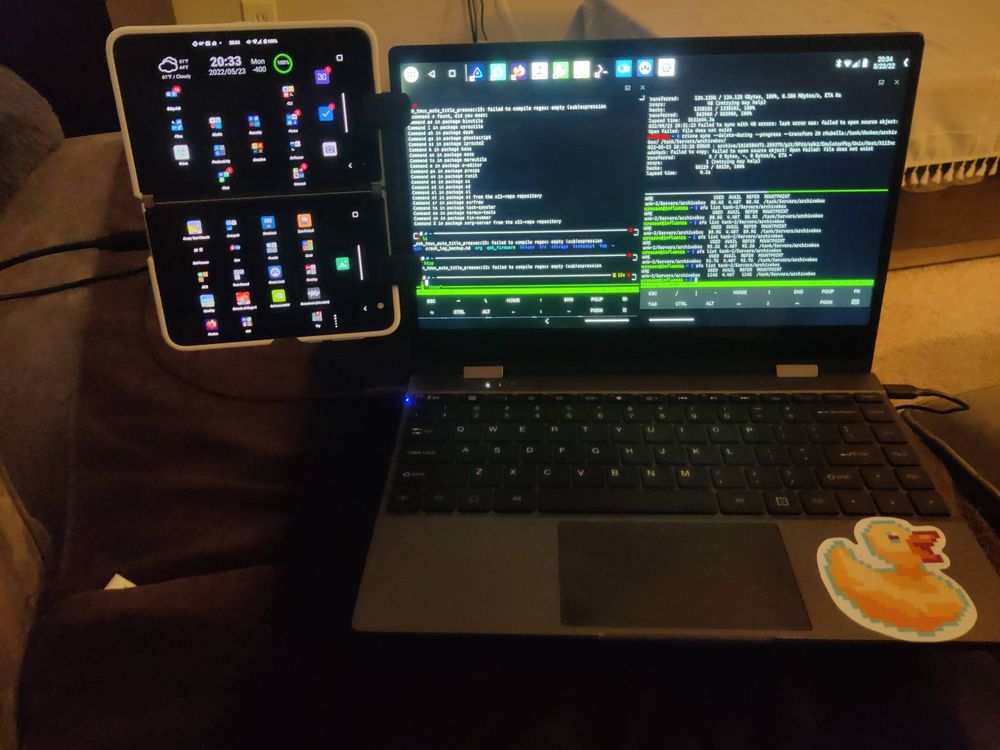Changelog
- 2023-02-18
- Add note about device swaps and Android 13 upgrade issues
Update 2023-02-18
As of 2023-02-18 I no longer use a OnePlus 8T or Microsoft Surface Duo, both of which are described below. The OnePlus 8T received an Android 13 update that was so buggy for desktop mode, it was unusable. The Surface Duo received an Android 13 update that forced desktop mode to only allow using Remote Desktop for some kind of ‘convergence mode’ that isn’t officially announced or released as of this writing.
Due to the desktop mode breakages, among other major firmware hiccups, I ended up migrating my device to a Samsung Galaxy Z Fold 4. It works great as a phone, tablet and has a dedicated desktop mode that works great with the below.
Please verify and consider the buggy nature of Android devices that have a desktop mode but not as a primary feature. Samsung has prioritized desktop mode support and it works. Others can work with one firmware version and not the next.
Please be mindful when selecting a device for the below.
My thoughts on the Samsung Galaxy Z Fold 4 can be found here (link).
Forward
It’s strange. I’ve not owned or used a Laptop in months. Over three actually, the longest I’ve gone without using a Laptop, Ultrabook, Netbook, UMPC or anything resembling a ‘desktop’ environment that’s mobile. Multiple years for anything not a 13.3" ish clamshell even.
I no longer need these sorts of devices to be effective when mobile. My phone has long been a powerhouse of of a computer. Smart phones are just advanced computers these days with a highly tuned UI for smaller screens. I’ve also wanted a single ‘compute node’ that I can carry around and ‘dock’ into varied HID (human interface device) setups based on what I need to be productive.
These days I have a set of three 1440p monitors, 40% keyboard, trackball, trackpad and whatnot hooked up to my main desk computer. On the go I have a Surface Duo for ’tablet’ and ‘phone’ duties. Thats a great spread of HID coverage and I honstely adore the Duo for my lighter duty compute needs like reading, note taking, basic server updates, and general productivity needs. The desktop can do all my photography processing, firmware development, self-hosted cloud management and more when I have a proper need for ’lots of monitor’ or ’lots of non-battery powered compute’.
It’s easy to see how I stopped using my laptop and why I sold it without having a replacement in-hand. I didn’t need a laptop at all, my Duo covers 90% of why I had a laptop. My laptop became just one extra device with a battery sitting there waiting for the rare occassion I had a true use. Trouble is not everything auto-updates when not running and since I don’t leave every possible app I may use open and running on a computer I’m not actively using… I invariably had to spent time running All The Updates every time I sat down to use it. By the time the updates were sorted I was rarely intersted in using the laptop and lost my window of opportunity. My rare occasion of use became an internal monologue about even bothering to begin with. That’s a big hurdle to clear for regular use.
I used a laptop 3 times in 3 months coming into my laptop hiatus. Is that even worth the hassle or cost of maintenance? I don’t think so. Especially with knowing it was idle for 3 months after the last use. That’s only 3 uses inside a 6 month window. That’s not even close to a ’need’ for me. That’s pure waste of electricity and electronics territory. So, I sold it to someone who uses it heavily to this day. They got a great workhorse of a laptop and I was able to have a beautiful “hold my beer” moment.
Enter the Lapdock. I was reminded of the old Motorola Atrix dock right about the time I decided to sell my Laptop. The Atrix dock turned a phone into a laptop back in 2008 or so (way ahead of their time). I decided to see if that concept had continued. It has. It’s called a `Lapdock` by the internet at large
Some searching, counting of cash and much patience yielded a uPerfect Lapdock (link) and NexDock Lapdock (link). These are essentially Laptops without brains. The work the same as a standard USB-C dock except they have on board monitors, keyboards, touchpads and batteries. The best part is they can work with just HDMI input for display and USB out for the keyboard/mouse allowing you to use them as keyboards/monitors/mice for servers and other types of computers that expect to work with discreet HID components. Including desktop computers. I tried, it works surprisingly well as a plug and play dock.
Please note: I will not be reviewing the lapdocks mentioned above in this post. This post is about the lapdock concept, not specific hardware.
Lapdocks are flexible for their use cases. So much so I really wish they were a common paradigm for folks.
I’ve been using both lapdocks I ordered heavily thanks to the flexibility. I actively seek them out for certain tasks instead of my desktop computer. I’ve had the Duo setup as a phone/tablet hybrid for general productivity work for a long time now. Including some basic programming and server maintenance work. Now? Now I hookup a lapdock and use it as my go to device at home. I use it as my default device at my $dayJob so I don’t have to use my work provided computer for anything personal. I’ve printed a Microsoft Word document via a consumer grade networked printer from it. I’ve compiled uf2 firmware using it. I’ve successfully flashed uf2 firmware to embedded devices using it. I’m writing and editing this post via a Duo + NexDock lapdock.
At this point I’ve wholly replaced my Laptop with a foldable phone that can work as a phone or a tablet or laptop. Thank you Lapdocks.
I have that ever elusive compute node that just docks into other things if I need better monitors or keyboard or pointing device. I can swap out my HID layout without sacrificing any of my workflows, data or fundamental performance needs.
This is the point a lot of Alpha Nerds pounce to try to evicerate the fact I’m this productive on a ‘phone’ and basically bailed on ’traditional’ computing. But you can’t… But that’s less efficient… But it works different… But its Google’s walled garden… but… but… fucking but…
These Lapdocks enable broad desktop computing on a phone or tablet. My $1000 OnePlus 8T has matching specifications to a $1200 Laptop! My $750 Surface Duo? BETTER SPECS THAN A LAPTOP! These phones have a 2-3 year upgrade cycle which matches… A LAPTOP!
Please don’t Alpha Nerd and expose your tiny e-peen. It’s not a wholly open paradigm or rootable, that’s not remotely the point. It’s not ‘wholly capable’ via a rats nest of dongles or pci-express add-ons, that’s not the point either.
Like a laptop: the point is most humans wandering about this rock don’t care or need more than something that is portable, gives them a solid screen+keyboard+mouse/touch and covers their fundamental compute needs. Phones tend to cover all the fundamental use cases humans run into day to day. Laptops are not upgradable just like their tablet and phone counterparts.
The only difference here is physical size.
It’s also far cheaper to upgrade a single device over time. Lapdocks work with multiple types of phones, computers, tablets, and more. Upgrading a piece of hardware means you still have the Lapdock and you start to save money over time by skipping a 2nd bigger device. Oops.
You also have fewer things to worry about and if the lapdock dies? You’re fine. Your phone dies? Well… who survives that cleanly? At least iCloud and Google backup have half a chance in hell of saving your data and come enabled by default. Few people I know backup a laptop or even think to back it up. Same for desktop computers and TV sticks. The risk model for cost and data loss start to look compelling with these factors. Double oops.
That said and all the gushing aside: This stuff is not perfect.
A number of apps that do heavy graphics can be confused by the external display or not work on them. Some apps get really confused by multi-monitor and some might crash outright. Desktop mode in the main Android Open Source Project is regarded as usable but full of quirks. Phone makers like Samsung, OnePlus and others have cleaned up some of these quirks but not all and certainly not consistently. Thankfully there are apps targeting desktop mode so you can smooth them over and better utilize the lapdock display. It’s the same experience a nice phone dock provides to the user.
The touch pads can also be weird to use on mobile. Between the touch UIs and sometimes odd default settings, it’s a mild adjustment. My Duo has some really funky default settings and it works ok but I find myself preferring the touch screen or a bluetooth trackball for daily use. It isn’t a major problem for me but is worth noting. The keyboards and screen are sound thankfully, including touch support on the screen. On the Duo I find myself using the touch screen instead of trackpad most of the time. In general I’m liking the keybord and monitor these have. It’s as good as my old laptop for screen/keyboard.
I gloss over the quirks and potential issues above as I have Opinions about my computing environments on the whole. Lapdocks plus Android piss me off a lot less than most other options and that’s the best endorsement I can give. It’s also what my friends would consider a ‘glowing endorsement’. It gets out of my way enough I’m willing to use it with frequency. Unlike my laptop that got in my way with updates, this Just Works when I need it. I’ve also sorted any quirks or issues over the last month and found workflows to work around them. The workarounds are really simple too, like preferring the touch screen to track pad.
None of this stops or changes the broad utility of the lapdock. Yes, there may be a few odder edge cases that are problematic but I have plenty of that (and a fuck load more) on any operating system or hardware. How often does your computer running Windows, OSX or Linux (pick anything but a tui) Just Work for the duration of use? Not every time that’s certain. Nothing electronic is without serious quirks or problems. It’s a given thanks to the inherent complexity of modern computing environments. Hell, if you’re computer is old enough you may not be able to run an app, that’s always fun. That holds true with phones and tablets too. I believe we call that ‘feature parity’ in other contexts.
The messes are ever present, we just pick the one that smells least terrible. The lapdock is a very good choice for making things less smelly over time for a lot of humanity.
I’d offer a good example from my daily non-mobile computer use but I think we all have a good “well that is broke and I’m stuck with a work around” story related to our ‘real computers’ and I’ll spare you additional words to read. Let’s just suspend disbelief and insert our own, tragic, ‘real computer’ horror story here.
For mobile and lapdocks, I have a good example that I’m not fond to admit exists. The official Microsoft RDP app on Android locks out screen overlays and a bunch of stuff (security/privacy stuff that’s 100% valid and appreciated). Unfortunately this caues the external display to go haywire once the app is closed. If I disconnect and re-connect the lapdock the problem goes away. Is this ideal? Not in the least. Is it a deal breaker? Not in the least. Is this a consistent issue across devices? Kinda.
My OnePlus has a better trackpad implementation and glitches like the Duo when closing the official RDP app. However, it takes longer to recognize and connect to a lapdock than the Duo. I have to make a choice when using RDP with the lapdock. Better mouse but terrible if I need multi-window or multi-app use versus horrid mouse but good multi-window and multi-app use. Not an easy call sometimes, especially on the go and cramped into a seat on some form of transit. This also reads like a really crappy scenario to have to manage.
Why would I deal with this?
A requirement of my $dayJob is pager duty which means I need RDP handy at all times, even if that means using only my phone for emergency response. The situation determines if I use RDP on the Duo or OnePlus. If I can use an external trackball/mouse/etc I go straight for the Duo, if I need the lapdock track pad I go straight for the OnePlus. Even if I wasn’t a dual device user (multi-device means I can use the ‘off’ device normally while RDP ties up the other), I’d proabably tough it out no matter what as I have to use RDP regardless of situation at times. I’d just meter my usage more carefully while watching for better solutions to the quirks my device(s) bring to bear. I’ve tried a few alternatives and they have different quirks that aren’t for me. There are options though and that’s a good thing for finding work arounds that work for an individual.
This example is probably the best anti-lapdock argument you can make. There will be some app that just does not work right with a lapdock setup. How critical is that one app to your situation? Mine’s pretty damn important as I need it in case of emergency so… I make due. That may or may not be possible for you.
On the other side of that, I have over 200 apps on my Duo. Programming environments, productivity environments (calendar/contacts/notes), remote server management enviornments, games, media and more. My Duo is a laptop unto itself. So are most iPads, iPhones and Android phones. The trick was connecting a more robust display, keyboard and pointing device. The most critical HID elements.
What is a laptop beyond a rough physicl size, weight and components that allow you to do computery things? It’s a format, not a device.
My phone is a laptop. Hold my beer, indeed.
This also exposes your mobile device as a desktop computer. You can get a USB-C dock and hookup a keyboard, monitor and pointing device. That dock will suddenly make your phone a computer with multiple monitors along with a keyboard/pointing device you prefer. This was a fun one to test and tinker with, it felt like I was using my siblings ‘real computer’ setup but it was my Duo making the magic happen.
My phone is a general computer. It should be “Hold My Keg”, right?
You can print a word document from your Android phone. You can program embeded devices from your Android phone. You can do a lot with a modern phone. Why not make it a full computer if you don’t have a specific use case that calls for an alternative?
Phones are computers, it’s just a matter of Human Interface Devices (HID) that dictate what it’s called. Why not change the HID and move on with life without a care or thought?
I think you should. I really can’t argue against it unless you have a specific need that is incompatible.
Our phones and tablets are the 85-90% case. We should really be leaning into this reality and slow but steady change. We’ve been aimed this direction since the original Palm Pilot was released.
I’m loooking forward to the day my desktop can go away and I’m down to a little black box that plugs into varied HID setups and gets the hell out of my way.
For now I’ll keep plugging away at creating cool stuff via the Duo + NexDock lapdock enjoying the simplicity and ease of use for all of my primary computer needs.



